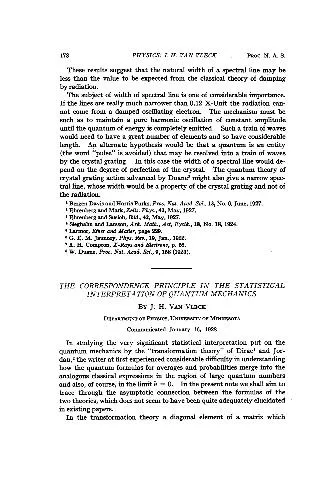The Correspondence Principle in the Statistical Interpretation of Quantum Mechanics
3.8
بر اساس نظر کاربران

شما میتونید سوالاتتون در باره کتاب رو از هوش مصنوعیش بعد از ورود بپرسید
هر دانلود یا پرسش از هوش مصنوعی 2 امتیاز لازم دارد، برای بدست آوردن امتیاز رایگان، به صفحه ی راهنمای امتیازات سر بزنید و یک سری کار ارزشمند انجام بدینمعرفی کتاب "The Correspondence Principle in the Statistical Interpretation of Quantum Mechanics"
کتاب "The Correspondence Principle in the Statistical Interpretation of Quantum Mechanics" یکی از برجستهترین آثار علمی در حوزه مکانیک کوانتومی و اصول پایهای آن است. نگارش این کتاب توسط نویسنده برجسته، "Van Vleck J. H." باعث تحولی در درک و تفسیر آماری Quantum Mechanics شده است. این کتاب خواننده را به سفر علمیای عمیق میبرد تا اصول Correspondence Principle و ارتباط شگرف آن با مکانیک کوانتومی کلاسیک و آماری را کشف کند.
خلاصهای از کتاب
در این کتاب، نویسنده بهطور جامع به بررسی مفاهیم بنیادی همچون اصول Correspondence Principle و رابطه آن با Quantum Mechanics میپردازد. این اصل که به نوعی پل میان مکانیک کلاسیک و مکانیک کوانتومی محسوب میشود، زمینهای برای درک بهتر پدیدههای زیراتمی فراهم میکند.
از همان آغاز کتاب، تاکید بر اصول آماری در تفسیر اتفاقات کوانتومی آشکار است. نویسنده توضیح میدهد که چگونه فیزیکدانان اولیه مانند Niels Bohr از این اصل برای پیوند دادن رفتارهای ماکروسکوپی با میکروسکوپی استفاده کردهاند. با تمرکز بر اهمیت آماری رفتار ذرات و نقش احتمالات در مکانیک کوانتومی، این اثر، دیدگاهی علمی و فلسفی در رابطه با پدیدههای ناشناخته ارائه میدهد.
نکات کلیدی کتاب
- درک عمیق از Correspondence Principle بهعنوان یک میانجی میان فیزیک کلاسیک و کوانتومی.
- توضیح روشهای آماری برای تفسیر Quantum States و رفتار سیستمهای پیچیده.
- بررسی مفاهیم بنیادی همچون Wave-Particle Duality و نقش احتمالات در طبیعت.
- ارائه نمونههای تاریخی از توسعه مکانیک کوانتومی کلاسیک توسط ذهنهای بزرگی مانند Niels Bohr و Max Planck.
جملات معروف از کتاب
"The Correspondence Principle does not merely serve as a bridge; it is a guiding light in the nebulous field of quantum phenomena."
"Statistical Mechanics and Quantum Mechanics are not opposites; they are harmoniously interwoven in the fabric of reality."
چرا این کتاب مهم است؟
این کتاب بهعنوان اثری مهم و مرجع در حوزه مکانیک کوانتومی شناخته شده است. "Van Vleck J. H." با استفاده از سبک نوشتاری دقیق خود، توانسته موضوعات پیچیده را به شیوهای روان و قابل درک ارائه دهد. برای دانشجویان، پژوهشگران و علاقهمندان به دنیای فیزیک، این کتاب منبعی بینظیر برای درک ارتباط میان دنیای کلاسیک و کوانتومی است.
اهمیت دیگر این اثر، پرداختن به موضوعات پایدار و ابدی مکانیک کوانتومی است که همچنان در علم امروز مورد بحث و کاوش قرار میگیرند. با شناخت اصول آماری و فلسفی ارائه شده در این کتاب، میتوان نه تنها درک عمیقتری از پدیدههای طبیعی داشت، بلکه مبنایی علمی برای فلسفه علم نیز فراهم آورد.
The Correspondence Principle in the Statistical Interpretation of Quantum Mechanics
An insightful exploration into the intersection of classical physics and quantum mechanics, this seminal work examines the role of the Correspondence Principle in connecting old theories with the new frontier of quantum theory.
A Detailed Summary of the Book
"The Correspondence Principle in the Statistical Interpretation of Quantum Mechanics" serves as a meticulous investigation into one of the foundational tenets of quantum mechanics: the Correspondence Principle. The text delves deeply into this principle, initially articulated by Niels Bohr, which stipulates that the behavior of quantum systems must align with classical physics in the limit of large quantum numbers.
The author, Van Vleck J. H., bridges the abstract formalism of quantum mechanics with the statistical interpretations that give rise to its measurable outcomes. Through detailed theoretical analysis, mathematical reasoning, and historical context, readers are guided through a spectrum of topics ranging from the Schrödinger equation to the probabilistic nature of measurement in quantum systems.
The book is structured to address both classical enthusiasts and modern physicists, emphasizing the continuity of scientific advancement rather than a complete departure from established knowledge. Key concepts are introduced progressively, ensuring that both academic and curious minds can engage with the material. Special attention is given to showing how statistical laws in macroscopic systems emerge naturally from the quantum domain, highlighting the universality of physical principles.
Key Takeaways
- An in-depth understanding of the Correspondence Principle and its role in quantum mechanics.
- Clear illustrations of the statistical interpretation of quantum phenomena.
- A methodical approach to connecting classical and quantum physics, emphasizing their compatibility at macroscopic scales.
- Examples and reasoning that underline the robustness of quantum theory in explaining experimental outcomes.
- Insights into the philosophical implications of quantum theory’s probabilistic nature.
Famous Quotes from the Book
"The Correspondence Principle acts not as a departure from classical ideals but as a bridge to them, allowing us to navigate the quantum world with clarity."
"In the statistical domain of quantum mechanics, we come to recognize not chaos but an ordered unpredictability, tied irrevocably to nature’s fundamental laws."
"The unity of physics lies not in the abandonment of principles but in the realization that concepts evolve to accommodate the precision of our instruments."
Why This Book Matters
Quantum mechanics is one of the most remarkable achievements in modern science, yet its principles remain elusive to many. Through the pages of "The Correspondence Principle in the Statistical Interpretation of Quantum Mechanics," Van Vleck J. H. contributes significantly to our comprehension of its philosophical and practical underpinnings.
Why does this book matter? Simply put, it addresses the junction where classical Newtonian mechanics meets quantum theory. While the latter revolutionized physics, it did not erase centuries of prior knowledge. Instead, the Correspondence Principle showcases the harmony between these paradigms, ensuring that classical results emerge as quantum systems scale up. Van Vleck’s detailed exposition of this principle and its statistical interpretation provides a clear lens through which readers can view the coherence across physics’ subfields.
Furthermore, this book is foundational for anyone aiming to study quantum mechanics from a theoretical standpoint. It serves as a bridge for learners transitioning from classical concepts to a more probabilistic, statistical framework in the quantum realm. For academics and practitioners alike, the text offers both a reference and a medium for curiosity-driven exploration of the quantum world.
The book’s impact is both academic and philosophical, challenging readers to reconcile the deterministic viewpoint of classical physics with the inherent uncertainties in quantum mechanics—a challenge that remains just as relevant today as when the text was written.
دانلود رایگان مستقیم
برای دانلود رایگان این کتاب و هزاران کتاب دیگه همین حالا عضو بشین
برای خواندن این کتاب باید نرم افزار PDF Reader را دانلود کنید Foxit Reader


